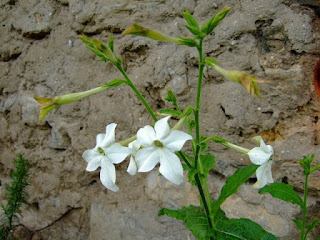 This post will be short on visuals, since everything mentinoed below is "future tense" until it actually grows. So I'm just throwing in a couple pictures I like. At right is a nice little vignette from the Elisabeth Miller Botanic Garden - a Japanese maple, Epimedium and Omphalodes cappadocica (thanks to Miguel for his correction!), a plant I loved and always killed in my Seattle garden. Omphalodes and water-sucking Japanese cherry roots don't mix well.
This post will be short on visuals, since everything mentinoed below is "future tense" until it actually grows. So I'm just throwing in a couple pictures I like. At right is a nice little vignette from the Elisabeth Miller Botanic Garden - a Japanese maple, Epimedium and Omphalodes cappadocica (thanks to Miguel for his correction!), a plant I loved and always killed in my Seattle garden. Omphalodes and water-sucking Japanese cherry roots don't mix well.I bought a lot of seeds in Seattle, including seeds of things that I'd probably not bother with if plants were available, but they aren't available here...and I enjoy growing from seed anyway. Commercial seeds I got are:
Scarlet runner beans, blue picotee morning glory, moonflower, Mina lobata, Asclepias tuberosa, a brilliant red oriental poppy, Orange-red nasturtiums, mixed-color branching sunflowers, Lunaria annua (already common here but I never seem to come across it when it's got seed), bitter melon, white bitter melon, luffa, Monarda, white bitter gourd, miniature bottle gourd, long handle dipper gourd, indonesian bottle gourd, corsican flat gourd and bushel gourd. Will I get around to dealing with all of these this year? Probably not...because I also happened to be in town for the Northwest Perennial Alliance spring plant sale, and that's where you find some of the really interesting stuff:
Arisaema speciosum, Alcea ficifolia, Alcea rosea (pale yellow with orange-pink throat), a "big sprawlilng" sky-blue flowering geranium, Arisaema flavum, Dolichos lablab, Nicotiana mutabilis, Meconopsis cambrica (yellow, supposedly banana-scented though mine never were before), Campanula persicifolia (common as dirt but I like it), Hesperis matronalis, Salvia canariensis, Euphorbia baselicis, Euphorbia characias 'Portuguese Velvet," Salvia subpalmatinervis (!), Dierama pulcherrimum, Zea Mays "Quadricolor" (a variegated corn with red popcorn kernels - excited about that one!), Aquilegia formosa, Geranium pyrenaicum "Bill Wallis" and Lupinus Arboreus. Plus some seeds of peony species (which take about 2 years to germinate), Thalictrum delavayi, Primula poisonii and Primula pulverulenta.
There's a lot of space out there - my problem before was always "where will I put this plant?" Now I'm challenged with actually being able to think about composition, what will do well and look good next to what, how much of something to plant...! But all gardeners eventually do come up against their wall...it might be space, climate limits, money, time...mine might be the limit of work I'm realistically willing to do!
I wonder how many nurseries were opened when hopeless plant sluts decided they needed to justify their hours monetarily?
Okay, another picture just to keep things flowing. This was already in my new garden - Lonicera periclymenum, or woodbine. Usually I see Japanese honeysuckle in Istanbul (don't worry, we got that one too), so when this came into bloom I was happy to see that it was L. periclymenum, a plant I've loved for a long time. Fragrance, color, nice bunches of berries in the fall, and not nearly so aggressive as its Japanese cousin. It's situated right at the entrance of the garden so its scent serves to remind one that this is a different space, please check your laptops at the gate! (Unless you are writing about gardens...)

 I could write for days on things I saw in Seattle and fill lots of space with photos...but this blog is ostensibly about gardening in Istanbul, not missing Seattle! So for those who are interested, I'll post the link to my picasaweb photos below.
I could write for days on things I saw in Seattle and fill lots of space with photos...but this blog is ostensibly about gardening in Istanbul, not missing Seattle! So for those who are interested, I'll post the link to my picasaweb photos below.


 I took a month-long break from istanbul to visit my mother in Arkansas and spend time in Seattle, the closest thing I have to "home" in the U.S. During the time I've been in Istanbul, I almost always visit Seattle in the autumn or winter, because tickets aren't cheap! This time I said "what the hell" and went in what to me is the most beautiful time of the year there, April and early May. And got an economical ticket to boot. It would have been even more economical if I hadn't missed my return flight and paid a $200 change fee...! But "sağlık olsun" as we say here - at leas we've got our health!
I took a month-long break from istanbul to visit my mother in Arkansas and spend time in Seattle, the closest thing I have to "home" in the U.S. During the time I've been in Istanbul, I almost always visit Seattle in the autumn or winter, because tickets aren't cheap! This time I said "what the hell" and went in what to me is the most beautiful time of the year there, April and early May. And got an economical ticket to boot. It would have been even more economical if I hadn't missed my return flight and paid a $200 change fee...! But "sağlık olsun" as we say here - at leas we've got our health!



